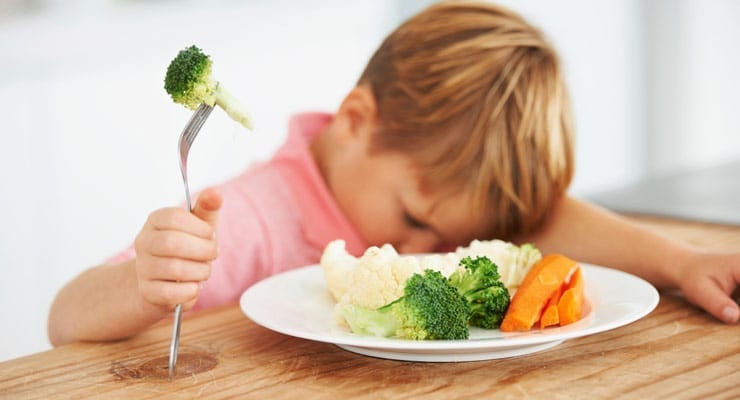As moms, we all have those (dirty) little secrets that we only share with our closest mom friends, or after we have had one too many glasses of wine.
Well, I have decided to come clean with mine. I am obsessed with nutrition and eating healthy. And that is why one of my secrets (other than how often I really bathe my kids) is so distressing to me.
My son, who is six, has never eaten a vegetable (that he knew was a vegetable)… to my knowledge. And trust me, I have tried. Luckily, I have gotten pretty good at pureeing veggies and sneaking them into his food, but I am hoping he will be able to learn to eat them on his own, at least by the time he goes off to college.
Most parents have probably been there at one point or another, trying desperately to get a child to eat their food and nothing seems to work. It is called PES – Picky Eater syndrome. Okay, I actually made that up, but why not give it a name?
So after doing some research, because the whole yelling/time out/punishment/bribery thing wasn’t getting the right results, here are some general tips (in no particular order):
1. Focus on three basics of diet: Balance, variety, and moderation.
2. Encourage a balanced diet that includes a variety of foods from all the food groups, but also in moderation. Yea, I know… easier said than done.
3. No matter what, offer at least one fruit and/or one veggie at each snack and meal.
4. Offer variety, even just a little. No one food has all the nutrients that you need, so if you find that you’re giving your kids the same foods everyday (yea, I’m guilty of this one), even if it’s a really healthy food, it means that they’re getting the same nutrients, vitamins, and minerals every day. This means they are probably missing a few key nutrients every day too.
5. All foods can be included in a healthy diet. This is where the moderation part comes in… see #6.
6. Limit the crap. Foods high in fat, calories, or processed sugar should be limited, and be mindful of portion sizes — too much of any food isn’t good. My husband is a numbers guy, so after my daughter ate a bag of skittles one day, he calculated what the equivalent of that would be for him. My daughter eating one bag of Skittles was the same as him eating SIX bags of Skittles. Yikes!
7. Divide foods into three categories: Foods that are okay to eat all the time, foods that are okay sometimes, and foods that kids are almost never allowed to eat.
8. Do not use food as a reward. I am way guilty of this one. And I may not be able to completely comply, but when we use food as a reward, kids can get really focused on the reward foods as being better than all the other foods… the ones that are healthy and good for them. Most moms I know don’t reward their child with a piece of broccoli.
9. Consider overall nutrition over a week, not per day, or per meal, because it’s normal for children’s eating to be inconsistent from day to day or meal to meal. This also helps to alleviate stress out of every mealtime when your child decides to eat one grape and one Ritz cracker for dinner. You know you can make up for it later.
10. Provide a go-to food. By offering at least one preferred food at a meal or snack, you know your child is at least going to eat something on the plate. Even if it is a hot dog, cheese burrito, or bowl of baked beans. And only offer one new or “challenging” food at a meal or snack. When you present a new food, offer their preferred food first to set the tone, then offer a new food followed by another familiar or preferred food.
11. Don’t force feed your kids. My husband and his parents often bring up the time when they stuffed garbanzo beans down his throat (and possibly up his nose). To this day, my husband refuses to eat garbanzos beans. When we force a child to eat something it teaches them to eat out of fear, but when the fear goes away the eating stops. And the child’s not learning the positives associated with food. It can be overall damaging to the child’s relationship with food… and the child’s relationship with you. Be their support system, not their enemy.
12. Hold off on beverages. Don’t give your child their drink until at least halfway through the meal; so the child doesn’t guzzle down the drink and then not eat anything.
13. Allow children to make choices whenever possible, and present choices where all outcomes are acceptable. Don’t set yourself up for a choice, that when they choose it, you won’t accept it.
It’s up to us to provide the food, but it’s up to our kids to eat it. So if we make it as enjoyable for them and as stress free for us, everyone wins. Good Luck.





